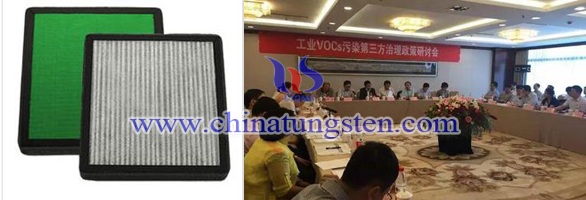Beijing Held Third Party Industrial VOCs Governance Policy Seminar, Tungsten Trioxide Photocatalyst Handle VOC
- Details
- Category: Tungsten's News
- Published on Friday, 17 June 2016 18:48
June 15th, the third party industrial VOCs governance policy seminar which organized by the State Environmental Protection petrochemical industry VOCs Pollution Control Engineering Technology Center and the National Federation of Chamber of Commerce held in Beijing, in-depth discussed the status quo of VOCs market, analyzed the existing problems of development in this industry, and made recommendations for a number of system construction stage of industrial VOCs third-party governance and management.
The important means of controlling VOCs during the Thirteen Five period is "comprehensive treatment + oil and gas recovery + source control." During the Thirteen Five period, China predicts to carry out a comprehensive improvement of VOCs in the petrochemical, organic chemicals, surface coating, packaging, printing and other industries. In China, VOCs (volatile organic compounds), refers to the all volatile organic compound corresponding which saturated vapor pressure at room temperature, and greater than 70 Pa, an organic compound having a boiling point at atmospheric pressure below 260 ℃ or under 20 ℃ condition vapor pressure greater than or equal to 10 Pa.

After years of research, photocatalytic technology to governance VOCs has been large-scale used in the China industrial waste-gas fields, and constantly improve the industry to form a series of organic light catalytic exhaust gas purification device. Studies have shown that the tungsten trioxide photocatalyst is a very effective catalyst to governance VOCs, which can eventually break down the volatile organic compounds into harmless carbon dioxide and water under the action of light. Thus, the photocatalyst has the functions like strong sterilization, deodorant, anti-mildew, air purification. In particular, the composite tungsten trioxide photocatalyst, such as doped ceria, yttria, lattices of tungsten trioxide itself have changed due to the contamination of other metallic elements, the advantageously combination with the composite metal enhanced photocatalytic activity. However, the doping amount of the metal should not be too much, otherwise it may be counterproductive, on the contrary, it will lower photocatalytic activity of the photocatalyst.
| Tungsten Oxide Supplier: Chinatungsten Online www.tungsten-oxide.com | Tel.: 86 592 5129696; Fax: 86 592 5129797;Email:sales@chinatungsten.com |
| Tungsten News & Prices, 3G Version: http://3g.chinatungsten.com | Molybdenum News & Molybdenum Price: http://news.molybdenum.com.cn |



 sales@chinatungsten.com
sales@chinatungsten.com